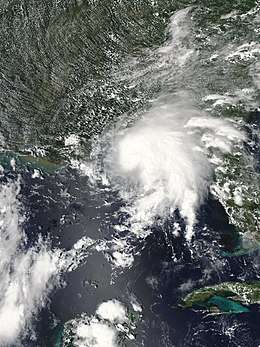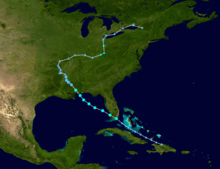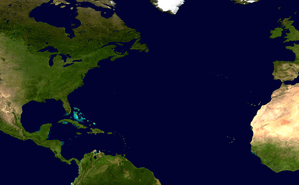Tropical Storm Gordon (2018)
| Tropical storm (SSHWS/NWS) | |
 Tropical Storm Gordon near peak intensity just off the coast of Alabama on September 4 | |
| Formed | September 3, 2018 |
|---|---|
| Dissipated | September 12, 2018 |
| (Remnant low after September 8) | |
| Highest winds |
1-minute sustained: 70 mph (110 km/h) |
| Lowest pressure | 997 mbar (hPa); 29.44 inHg |
| Fatalities | 2 direct, 1 indirect |
| Damage | > $250 million (2018 USD) |
| Areas affected | Hispaniola, Cuba, The Bahamas, South Florida, Florida Keys, Gulf Coast of the United States, Arkansas, Missouri, Eastern United States, Southern Ontario |
| Part of the 2018 Atlantic hurricane season | |
Tropical Storm Gordon was a tropical storm that caused moderate damage along the Gulf Coast of the United States in September 2018. The seventh named storm of the 2018 Atlantic hurricane season, Gordon, developed from a tropical wave that was first monitored in the Caribbean Sea on August 30. The wave moved west-northwestward toward the east coast of Florida and gradually organized. The disturbance was marked as Potential Tropical Cyclone Seven on September 2, while near the Bahamas, and early on September 3, it became Tropical Storm Gordon, moving onto the southwest coast of Florida shortly afterward. Steady intensification began after it left the coast of Florida into the Gulf of Mexico, reaching its peak intensity as a high-end tropical storm late on September 4, before it made landfall just east of Pascagoula, Mississippi, shortly afterwards. Gordon was expected to intensify further by the NHC, and respective watches and warnings were issued, but it failed to do so, leaving peak intensity just below hurricane strength at 70 mph (110 km/h). The storm moved inland, before weakening into a remnant low on September 8. Gordon's remnants moved as far as Southern Ontario, Canada, before being absorbed by another frontal system on September 12. At least three deaths have been attributed to the storm, and Gordon caused over $250 million (2018 USD) in damages.[1]
Meteorological history

On August 30, 2018, the National Hurricane Center (NHC) began monitoring a tropical wave over the north-central Caribbean Sea for tropical cyclone formation. Development was expected to be slow to occur due to unfavorable upper-level winds, although the environment was expected to become more favorable once the disturbance reached the Gulf of Mexico.[2] The tropical wave began to organize after leaving the Caribbean Sea on September 1. Due to its threat to the United States and an increasing organization trend, the NHC initiated advisories on Potential Tropical Cyclone Seven late on September 2.[3] Early on the following day, the disturbance developed a closed circulation and well-defined center, while it was situated off the coast of Florida, and the NHC classified the system as Tropical Storm Gordon.[4] Shortly afterward, the center of Gordon passed over Key Largo, Florida.
Shortly after Gordon moved offshore from Florida, a small eye became apparent on radar imagery, although it soon became eroded, and the surrounding convection became somewhat ragged.[5] The structure of the small core of Gordon continued to deteriorate throughout the evening as light to moderate westerly shear affected the system, although the storm continued to intensify.[6] However, Gordon soon began to organize once again, with lightning activity increasing in the inner core and a band of deep convection developing very near the core.[7] Gordon moved northeast through the Gulf of Mexico, in the general direction of New Orleans. Gordon was expected to intensify to a Category 1 hurricane shortly before landfall,[8][9][10][11][12] and hurricane warnings were issued accordingly for Mississippi and Alabama.[13] However, Gordon remained a tropical storm and did not intensify into a hurricane before making landfall near the Mississippi–Alabama border, with maximum sustained winds of 70 mph (110 km/h) at 10:00 p.m. CDT, September 4.[14] Afterwards, rapid weakening occurred as Gordon moved further inland on September 5, meandering around the state of Arkansas before it degenerated to a remnant low on September 8. The remnants of Gordon continued generating flooding rainstorms in the Northeast, before being absorbed by another frontal system over New England, on September 12.
Preparations and impact
Florida
Tropical Storm Gordon formed near the Florida Keys and brought tropical-storm force winds to southern Florida. Governor Rick Scott of Florida urged Floridians to prepare and "remain vigilant."[15][16] Shortly afterwards, a hurricane warning was issued in Mississippi and Alabama, with tropical-storm warnings extending around it into Louisiana and the Florida Panhandle.[17] Around 10 inches (250 mm) of rain fell in Pensacola, Florida. The Mississippi Gulf Coast also experienced minor floods, and winds over 50 mph (80 km/h). Several locations in southern Florida observed tropical-storm-force winds gusts, including a gust of 51 mph (82 km/h) in Opa-locka. More than 8,000 people were left without electricity in Broward and Miami-Dade counties. One death occurred in Miami on Interstate 95 when a truck driver lost control of his vehicle, crashed into a wall, and was then ejected from the truck.[18][19] A second death was reported after a tree crushed a mobile home in Pensacola, killing a child inside.[14]
Alabama
Dauphin Island, Alabama bore the heaviest of Gordon. 3–5 ft (0.91–1.52 m) of storm surge struck the island, causing minor flooding.
Louisiana
Louisiana Governor John Bel Edwards declared a state of emergency for the state, deploying 200 Louisiana National Guardsmen, 63 high-water trucks, 39 boats, and four helicopters.[20] Mississippi Governor Phil Bryant and Alabama Governor Kay Ivey also declared states of emergencies.[21]
Kentucky
A Louisville cab driver was killed after being trapped by flood waters.[22] More than 3 inches of rain fell in Louisville, flooding streets, stranding cars, and causing the Louisville City FC soccer match to be suspended and the University of Louisville football game to be delayed.[23] In Morehead, a young child was swept in flood water and recovery efforts were ongoing as of September 9.[24]
See also
- Other tropical cyclones named Gordon
- Hurricane Katrina - a category 5 hurricane that took a similar path
- Hurricane Humberto (2007) – a rapidly intensifying tropical system that hit the Gulf Coast
- Tropical Storm Edouard (2008) – struck western Gulf Coast in early August of that year
- Hurricane Isaac (2012) – affected the Gulf Coast as a Category 1 hurricane
- Hurricane Nate (2017) – Category 1 hurricane that made landfall on the Mississippi Gulf Coast
- Tropical Storm Bonnie (2010) - weak tropical storm that moved through the Gulf
References
- ↑ "Global Catstrophe Recap - September 2018" (PDF). Aon Benfield. October 9, 2018. p. 4. Retrieved October 10, 2018.
- ↑ Michael Brennan (August 30, 2018). "NHC Graphical Tropical Weather Outlook Archive". Miami, Florida: National Hurricane Center. Retrieved September 3, 2018.
- ↑ Stacy R. Stewart (September 2, 2018). "Potential Tropical Cyclone Seven Discussion Number 1". Miami, Florida: National Hurricane Center. Retrieved September 3, 2018.
- ↑ Stacy R. Stewart (September 3, 2018). "Tropical Storm Gordon Special Discussion Number 4". Miami, Florida: National Hurricane Center.
- ↑ Stacy R. Stewart (September 3, 2018). "Tropical Storm Gordon Discussion Number 6". Miami, Florida: National Hurricane Center. Retrieved September 4, 2018.
- ↑ Daniel P. Brown (September 4, 2018). "Tropical Storm Gordon Discussion Number 7". Miami, Florida: National Hurricane Center.
- ↑ Stacy R. Stewart (September 4, 2018). "Tropical Storm Gordon Discussion Number 9". Miami, Florida: National Hurricane Center.
- ↑ Stewart (3 September 2018). "Tropical Storm GORDON". www.nhc.noaa.gov. Retrieved 6 September 2018.
…the cyclone is forecast to reach hurricane strength in 24-36 hours, just before landfall. For that reason, a Hurricane Warning has been issued for portions of the central Gulf Coast.… 36H 05/0600Z 30.6N 89.3W 65 KT 75 MPH...INLAND
- ↑ Brown (3 September 2018). "Tropical Storm GORDON". www.nhc.noaa.gov. Retrieved 6 September 2018.
24H 05/0000Z 30.0N 88.6W 65 KT 75 MPH
- ↑ Pasch. "Tropical Storm GORDON". www.nhc.noaa.gov. Retrieved 6 September 2018.
12H 04/1800Z 29.0N 87.5W 65 KT 75 MPH
- ↑ Stewart. "Tropical Storm GORDON". www.nhc.noaa.gov. Retrieved 6 September 2018.
12H 05/0000Z 29.8N 88.5W 65 KT 75 MPH
- ↑ Stewart. "Tropical Storm GORDON". www.nhc.noaa.gov. Retrieved 6 September 2018.
…Gordon to reach hurricane strength before landfall.
- ↑ Stewart (3 September 2018). "Tropical Storm GORDON". www.nhc.noaa.gov. Retrieved 6 September 2018.
…the cyclone is forecast to reach hurricane strength in 24-36 hours, just before landfall. For that reason, a Hurricane Warning has been issued for portions of the central Gulf Coast.
- 1 2 Max Golembo, Emily Shapiro with Melissa Griffin (Sep 5, 2018) [3:36 AM]. "Tropical Storm Gordon makes landfall in Mississippi; 1 death reported from storm". ABCNews.go.com.
- ↑ CNN, Susannah Cullinane and Eric Levenson. "Tropical Storm Gordon lashes south Florida as it heads toward Gulf Coast". CNN. Retrieved 2018-09-03.
- ↑ "Rick Scott on Twitter". Twitter. Retrieved 2018-09-03.
- ↑ "Updates: Tropical Storm Gordon forms; hurricane watch issued for Alabama coast". AL.com. Retrieved 2018-09-03.
- ↑ "Tropical Storm Gordon in South Florida: Power Outages, Rain, Rough Surf". The Weather Channel. September 3, 2018. Retrieved September 4, 2018.
- ↑ "One dead as car crashes jam highways connecting Miami and Miami Beach". miamiherald. Retrieved 2018-09-05.
- ↑ CNBC (2018-09-04). "Tropical Storm Gordon races toward US Gulf Coast". CNBC. Retrieved 2018-09-04.
- ↑ https://www.facebook.com/profile.php?id=1526386. "Tropical Storm Gordon bears down on northern Gulf Coast, with hurricane warnings in effect". Washington Post. Retrieved 2018-09-04.
- ↑ WDRB (2018-09-04). "Cab driver drowns in Louisville after getting trapped in high water". WDRB. Retrieved 2018-09-09.
- ↑ Novelly, Thomas; Hall, Shannon (8 September 2018). "Record-breaking rainfall causes flooding, wreaks havoc in Louisville". Courier-Journal. Retrieved 10 September 2018.
- ↑ WKYT (2018-09-04). "Morehead Mayor: Rescuers work to find child swept into culvert". WKYT. Retrieved 2018-09-09.
